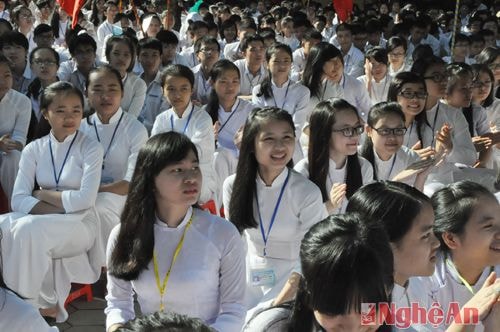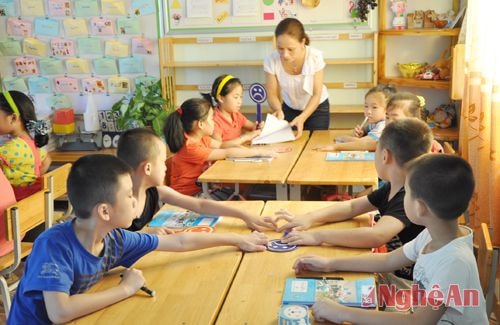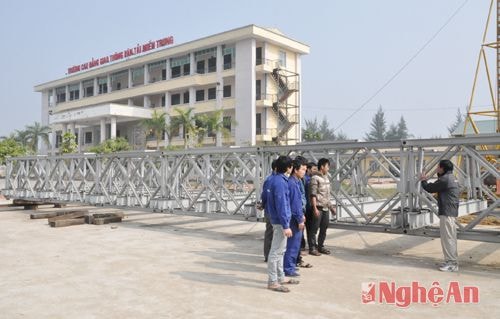Resolving conflicts in educational innovation
((Baonghean) - One of the strategic tasks stated in the Draft Political Report submitted to the 12th National Party Congress is: "Fundamental and comprehensive innovation in education and training; human resource development".
 |
| Students of Phan Boi Chau High School for the Gifted at the opening ceremony of the new school year. Photo: HN |
Based on a general assessment of the development of education and training, clearly stating the current limitations and weaknesses; the Draft Political Report identifies the general direction and 6 key tasks for fundamental and comprehensive innovation of education and training in the coming years. These contents were stated in Resolution No. 29 - NQ/TW dated November 4, 2013 at the 8th Central Conference, 11th term on innovation of education and training. However, with a capacity of only 3 pages (from page 35 to page 37), the content of this section is presented simply, not mentioning the conflicts that exist within the current education system. In our opinion, the Draft Political Report needs to clarify the following conflicts to have a solution:
Firstly, the contradiction between equipping knowledge and developing students' qualities and capacities. The draft Political Report clearly states: "Continue to strongly and synchronously innovate the basic elements of education and training in the direction of attaching importance to developing students' qualities and capacities." This viewpoint stems from the current state of Vietnamese education, which only focuses on equipping students with knowledge, without paying attention to developing qualities and capacities. In education, to develop students' qualities and capacities, it is necessary to equip them with knowledge. However, due to the current backward educational method, equipping knowledge is in conflict with developing qualities and capacities. For example, educating students in patriotism and national pride is a requirement to improve qualities. However, with the current method of teaching history, combined with the inclusion of this subject as an optional subject in exams, students have less and less understanding of national traditions, making it difficult to improve patriotism.
With other subjects, due to the way of teaching knowledge to students, it is not linked to the process of personality formation, does not create conditions for developing qualities and abilities. The contradiction between equipping knowledge and developing qualities and abilities manifests in many forms such as: only learning theory without practicing practical skills; "cramming" exam subjects, not studying other subjects; chasing after natural subjects, not liking to study social subjects, especially history; teaching in the style of "reading and copying" does not stimulate independent thinking of students. The situation of extra classes, overloaded learning, studying without time for entertainment... makes students unable to develop their intelligence and personality. On the surface, students are equipped with a lot of knowledge but in reality, it does not create a foundation for developing qualities and abilities. To overcome this contradiction, it is necessary to thoroughly reform the current backward educational methods, applying advanced educational methods that link equipping knowledge with developing qualities and abilities.
 |
| Students of Hoa Hieu Primary School, Thai Hoa Town study using the VNEN method. Photo by Huu Nghia. |
Second, the contradiction between open education and improving the quality of education. The draft Political Report clearly states: "Perfecting the national education system towards an open education system, lifelong learning and building a learning society." Building an open education system is an inevitable requirement in the process of industrialization and modernization of the country, creating conditions for the development of a knowledge-based economy. However, open education is a fierce challenge to improving the quality of education.
Reality over the years has shown that when education is no longer confined to formal schools but is socialized with many rich forms of training (on-the-job training, distance learning, joint training, self-study training, etc.), the quality is increasingly decreasing. From intermediate, college, university and vocational training, on-the-job training forms are flourishing, making the quality of training uncontrollable. Open education will create conditions for citizens to learn for life, but how will we build a learning society when the quality of formal training and on-the-job training is increasingly far apart, to the point that many localities do not recruit on-the-job university graduates.
Hundreds of thousands of university graduates (both full-time and part-time) are currently unemployed, reflecting a reality: the quality of education does not meet social demands. Building a learning society will not have the motivation when hundreds of thousands of graduates are unemployed. The contradiction between developing an open education system and improving the quality of education is a reality that needs to be recognized in order to find a solution.
 |
| Students of the Central College of Transport practice research on steel beam structures. Photo by Huu Nghia. |
Third, the contradiction between examinations and assessment of educational quality. Examinations are a form of assessment of learning quality. But with millions of students attending school today, the quality of learning assessed through examinations is increasingly inaccurate. For many years, the education and training sector has maintained a dense examination system: test papers, coursework tests, semester exams, year-end exams, transfer exams, graduation exams, university entrance exams, entrance exams to specialized schools and selective classes. Most of these forms of examinations do not accurately assess the quality of students.
The graduation rate does not reflect the quality of education but becomes a measure of achievement. To overcome this contradiction, the education and training sector has continuously improved the forms of examinations in the direction of becoming simpler and more convenient. A "revolution" in examinations is to combine the graduation exam with the university entrance exam into a national exam to both assess the quality of students and get the results of university and college admission.
The simplification of examinations is widely supported by public opinion, but experts are raising the question: when there are no more exam scores (or test scores), what basis is there to evaluate the quality of students? Evaluation by learning outcomes must be based on transcripts, which still must include scores and comments from teachers. Are the scores recorded in transcripts accurate enough to measure students' abilities? Are the comments recorded by teachers in transcripts objective and comprehensive enough to properly evaluate students' qualities? It seems that although examinations have been improved, they are still in conflict with the assessment of educational quality. To resolve this conflict, we must continue to innovate the examination method according to the motto of doing and drawing experience from practice to make timely adjustments. What must be done so that examination results accurately reflect the quality of students' learning?
In our opinion, the Draft Political Report must generally address the above contradictions and propose practical solutions to fundamentally and comprehensively reform education and training.
TRAN HONG CO
